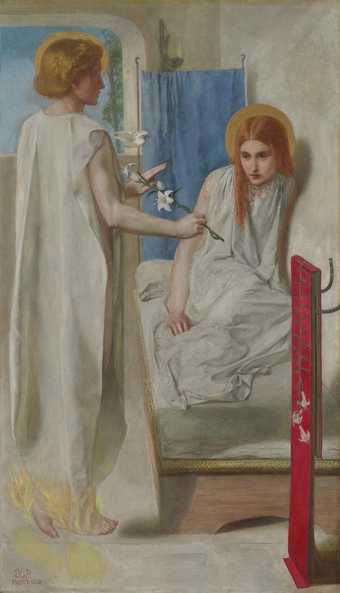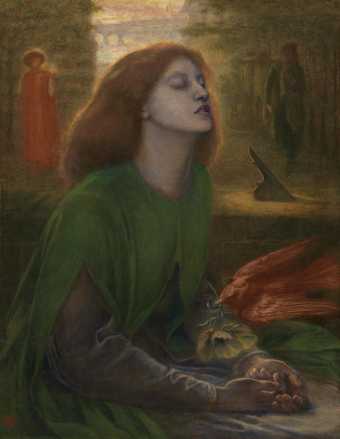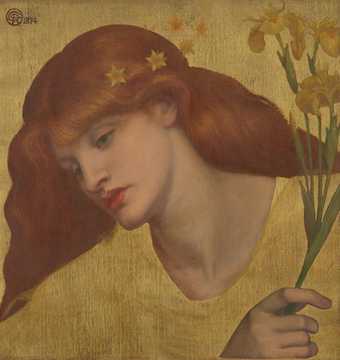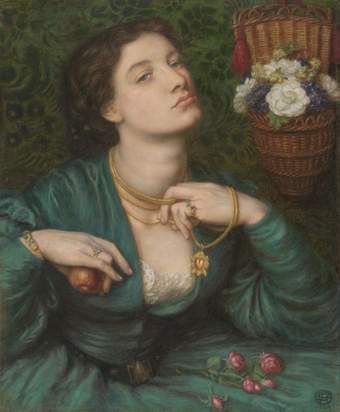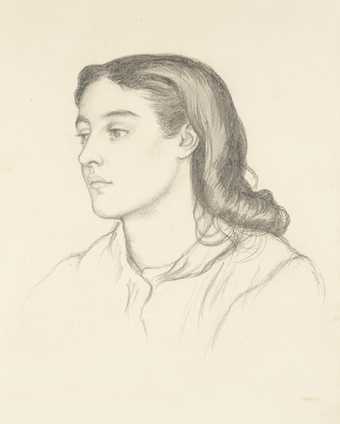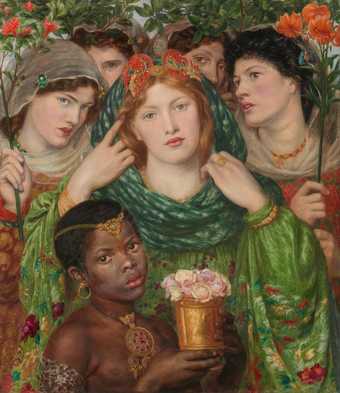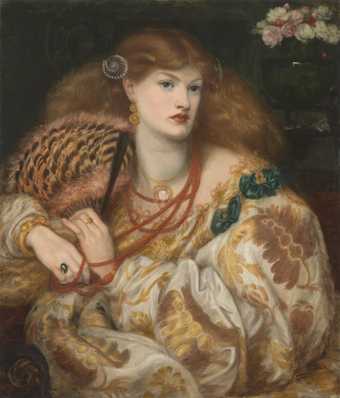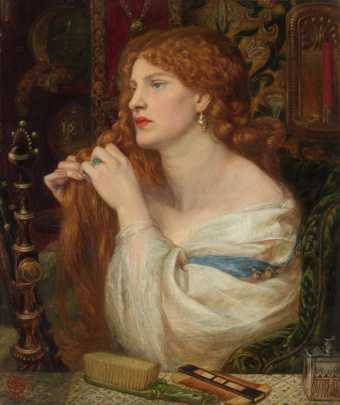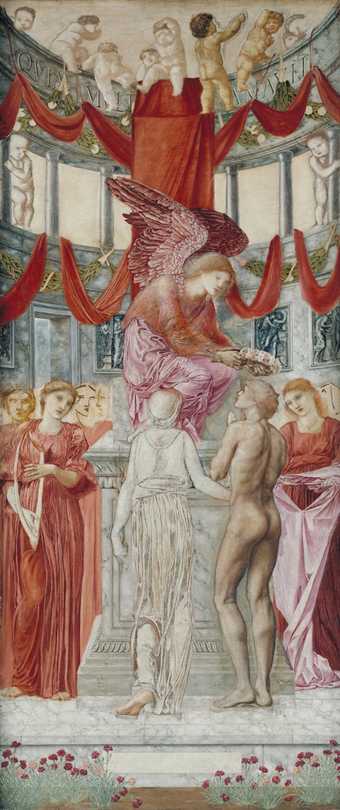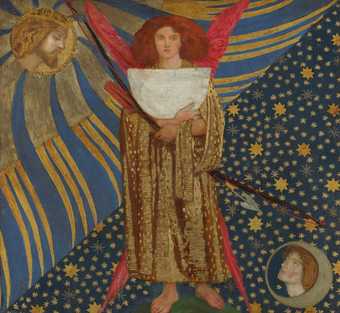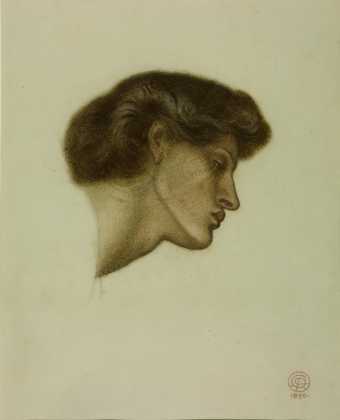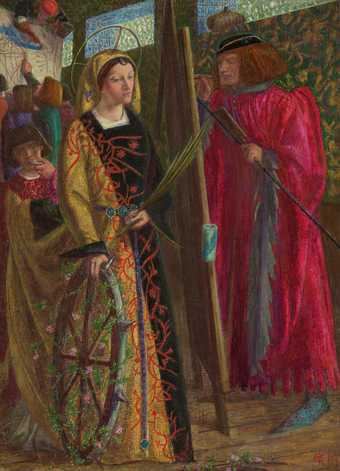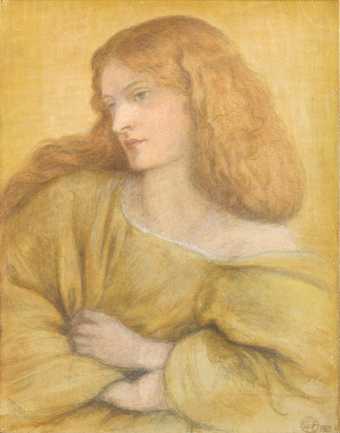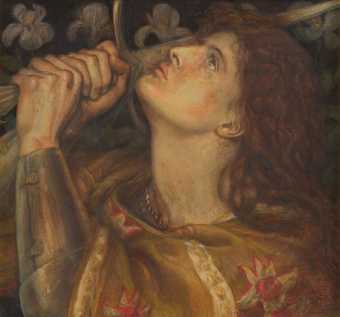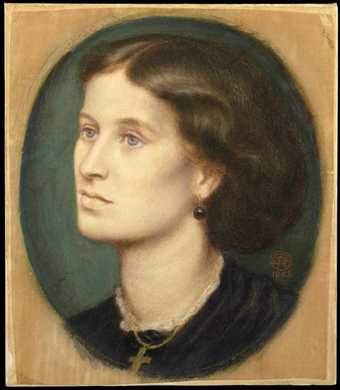
Not on display
- Artist
- Dante Gabriel Rossetti 1828–1882
- Medium
- Oil paint on canvas
- Dimensions
- Support: 1251 × 610 mm
frame: 1605 × 930 × 85 mm - Collection
- Tate
- Acquisition
- Presented by W. Graham Robertson 1940
- Reference
- N05064
Summary
Rossetti explained the subject of Proserpine in a letter to W.A. Turner, who bought a version of the picture in 1877:
The figure represents Proserpine as Empress of Hades. After she was conveyed by Pluto to his realm, and became his bride, her mother Ceres importuned Jupiter for her return to earth, and he was prevailed on to consent to this, provided only she had not partaken of any of the fruits of Hades. It was found, however, that she had eaten one grain of a pomegranate, and this enchained her to her new empire and destiny. She is represented in a gloomy corridor of her palace, with the fatal fruit in her hand. As she passes, a gleam strikes on the wall behind her form some inlet suddenly opened, and admitting for a moment the light of the upper world; and she glances furtively towards it, immersed in thought.The subject was suggested to the artist by William Morris, whose wife Jane was the model for this and many other works by Rossetti. Her own life bore similarities to that of the captive goddess, and the painting could be seen as much a portrait of Jane as a representation of Proserpine. By all accounts, Mrs Morris was not a happy woman and Morris was a cold husband. Jane enjoyed an intimate relationship with Rossetti which spanned decades. Rossetti painted Proserpine while staying with the couple at Kelmscott. Eight oil versions were made, most meeting with disaster of one sort or another. This, the seventh, was painted for the Liverpool shipping magnate F.R. Leyland, as a replacement for a previous version which was damaged in transit.
(W. Sharp, Dante Gabriel Rossetti: A Record and Study, London 1882, p.236)
Various symbols contained in the painting include the pomegranate, which signifies captivity and marriage, and the incense-burner, the attribute of a goddess. The decorative quality of the picture is accentuated by the curve of the ivy spray, a symbol of clinging memory, which is echoed in Proserpine's arm and the rich folds of drapery. The painting is inscribed with the artist's signature and date on a scroll at lower left: 'DANTE GABRIELE ROSSETTI RITRASSE NEL CAPODANNO DEL 1874' ('Dante Gabriel Rossetti painted this at the beginning of 1874'). Rossetti, who was also a poet, wrote a sonnet for the painting, inscribing it in Italian on the picture and in English on the frame:
Afar away the light that brings cold cheerThe frame, designed by Rossetti, is decorated with roundels which resemble a section through a pomegranate.
Unto this wall, - one instant and no more
Admitted at my distant palace-door.
Afar the flowers of Enna from this drear
Dire fruit, which, tasted once, must thrall me here.
Afar those skies from this Tartarean grey
That chills me: and afar, how far away,
The nights that shall be from the days that were.Afar from mine own self I seem, and wing
Strange ways in thought, and listen for a sign:
And still some heart unto some soul doth pine,
(Whose sounds mine inner sense in fain to bring,
Continually together murmuring,) -
"Woe's me for thee, unhappy Proserpine!"
Further reading:
Virginia Surtees, Dante Gabriel Rossetti 1828-1882. The Paintings and
Drawings: A Catalogue Raisonné, Oxford 1971, I, pp.131-4
Leslie Parris (ed.), The Pre-Raphaelites, exhibition catalogue, Tate Gallery, London 1984, reprinted 1994, pp.231-2
Terry Riggs
February 1998
Does this text contain inaccurate information or language that you feel we should improve or change? We would like to hear from you.
Display caption
In the classical myth Proserpine was kidnapped by Pluto, the god of the underworld, to be his wife. Eating food from the underworld would cause a living person to stay there forever. Proserpine ate six pomegranate seeds, and so Pluto confined her to his kingdom six months of each year. She is shown here eating a pomegranate which symbolises captivity. Jane Morris (née Burden) modelled for Proserpine. She was an embroiderer and artist’s model who was married to Rossetti’s friend William Morris and was also Rossetti’s lover.
Gallery label, August 2018
Does this text contain inaccurate information or language that you feel we should improve or change? We would like to hear from you.
Explore
- objects(23,571)
-
- food and drink(980)
- religious and ceremonial(1,733)
-
- censer(8)
- Morris, Jane(4)
- individuals: female(1,698)
- poem(157)
You might like
-
Dante Gabriel Rossetti Ecce Ancilla Domini! (The Annunciation)
1849–50 -
Dante Gabriel Rossetti Beata Beatrix
c.1864–70 -
Dante Gabriel Rossetti Sancta Lilias
1874 -
Dante Gabriel Rossetti Monna Pomona
1864 -
Dante Gabriel Rossetti Miss Robertson (Mrs Fernandez)
c.1866 -
Dante Gabriel Rossetti The Beloved (‘The Bride’)
1865–6 -
Dante Gabriel Rossetti Monna Vanna
1866 -
Dante Gabriel Rossetti Aurelia (Fazio’s Mistress)
1863–1873 -
Sir Edward Coley Burne-Jones, Bt The Temple of Love
date not known -
Dante Gabriel Rossetti Dantis Amor
1860 -
Dante Gabriel Rossetti Study for the Head of Love, for ‘Dante’s Dream at the Time of the Death of Beatrice’
1870 -
Dante Gabriel Rossetti St Catherine
1857 -
Dante Gabriel Rossetti Woman in Yellow
1863 -
Dante Gabriel Rossetti Joan of Arc
1864 -
Dante Gabriel Rossetti Mrs Vernon Lushington
1865

